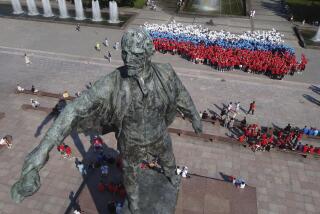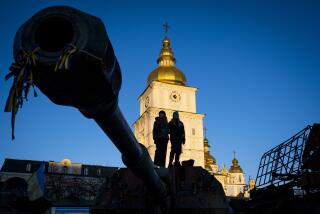BOOK MARK : Street-wise Perestroika: How to Score a Heineken
The peculiarities and crimes that pockmark Russia’s barbaric history are over, as every Soviet spokesman who haunted the foreign-press cen ter on Moscow’s Zubovsky Boulevard explained endlessly when I first walked into the place in 1985. It is pravda , they asserted, that the foulness of the past is at an end, liberty is at hand and Lenin’s preserved, shriveled brain is no longer being whacked with electrical implants by Lenin Museum scientists looking for clues to his genius.
And yet, like so much in the Soviet Union, that is only half of it. In street parlance, pravda is the state’s truth, not the truth at all. The word for real, unvarnished truth is istina . In a land whose rulers have mastered the art of refracting reality, pravda is a reflection in the state’s fun-house mirror. Istina is the Russian Zen, a higher plateau of consciousness extremely difficult and dangerous to reach. It has absolutely no connection to anything in the West. Reaching istina implies having secret knowledge.
During the turbulent era of Mikhail S. Gorbachev, a group of quite differently motivated young men and women, known as cooperators, came to share a belief in something far greater than perestroika . Risking their lives and reputations, sometimes alone in anguish and sometimes together in hostility, the cooperators walked a treacherous line between nuisance and enemy to push perestroika’s back up against the wall in an economic war of attrition. For these uneasy allies, perestroika was a point of convergence, a place where the menace of the past was destined to meet the promise of the future and, it was hoped, istina would be discovered.
“The public sector is dead and the cooperative sector very much alive and in constant trouble,” explained Vladimir (Volodya) Yakovlev, the charismatic chairman of Cooperative Fact, the Soviet Union’s first privately owned news and information service. “The manager of a factory that made T-shirts complained to me that cooperators had bought all his T-shirts, painted pictures on them and sold them for more money. He was amazed and angry at this. So I asked him why the factory didn’t paint the pictures on the T-shirts and sell them instead. He said he didn’t want to do it. This is why the public sector is dead and the cooperators face trouble.”
It was apparent to all of us involved in the cooperative revolution that the success or failure of the free-market movement, in purely economic terms, hinged on the ability of cooperators to disengage from the communist economy by breaking up the state monopolies. This was perhaps an impossible chore because of the extraordinary extent of Soviet monopolies and the pressure of the state to keep rigid control of its financial and industrial superstructure.
The most basic goods necessary for cooperators to rebuild the Soviet economy--steel, plastic, concrete, plywood--were produced entirely by a single organization and a single factory. The government ministries that controlled the system of manufacturing and services also exerted monopoly power over distribution through a network of territorial departments that made sure unhappy customers could not switch to an alternative supplier. The Kremlin crossed the taboo barring private property in late 1990 to help initiate economic reform through free-market enterprise. But this move to capture public enthusiasm for cooperatives and individually owned businesses remained tangled in the mechanism of the state monopoly, both practically and, more important, psychologically.
“I have no idea what the free market is,” explained one of many faceless Soviet shoppers waiting in a Moscow grocery line after five years of perestroika , her perplexed words echoing the national sentiment toward the new economic order advanced by the cooperators. “But I suspect this whole debate is really about how the same old apparatchiks are trying to control this new system and fill their pockets the same way they do now.”
Volodya Yakovlev saw perestroika as a chance to end the nation’s cynicism by involving the Soviet people in the free-market process. Unfortunately, there were few people who believed in the sincerity of the government’s various economic recovery plans or the cooperators’ dream. The ring of the word kooperativno , like the leper’s bell, announced a malignancy, possibly contagious, that prudent Russians thought better to shun in favor of the old methods of survival.
Hobbled by their inexperience and impatience with Western values and practices, too many Soviets found it easier and safer to work perestroika as an angle. In the bureaucrat’s lexicon, perestroika was a code word for manipulating one’s office to amass hard currency; perestroika on the street was often nothing more profound than an opportunity to score an exit visa or test a new angle on getting a beer.
“We cannot have passengers endangered because of the whim of someone who wants to drink beer in Finland,” said Valeri Kondratyev, the deputy chief of the Soviet Ministry of Aviation, commenting on the spate of Aeroflot hijackings by young Soviets toward the end of Gorbachev’s first five years in office. Taking advantage of the new freedom to leave the country or hold a plane hostage for a Heineken were perestroika’s most poignant metaphors.
BOOK REVIEW: “Bear Hunting With the Politburo,” by A. Craig Copetas, is reviewed on Page 1 of the Book Review section.
1991 by A. Craig Copetas. Reprinted with permission of Simon & Schuster, Inc.
More to Read
Sign up for Essential California
The most important California stories and recommendations in your inbox every morning.
You may occasionally receive promotional content from the Los Angeles Times.









